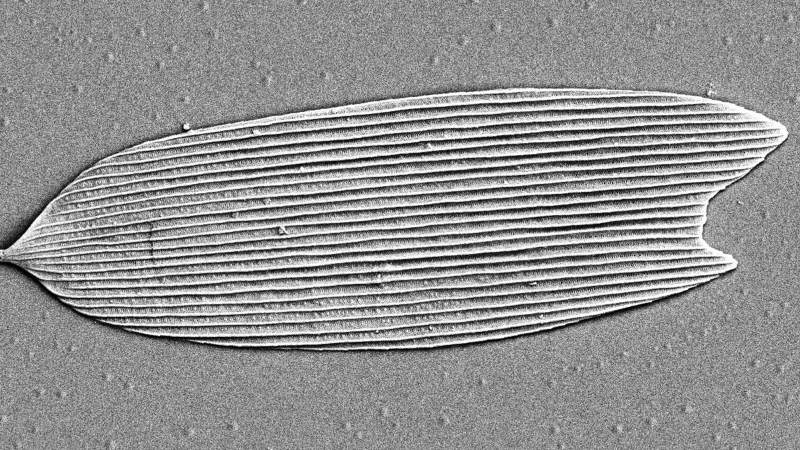Scientists working to advance the frontier of knowledge frequently also need to invent their tools along the way. Sometimes these are interesting little hacks to get a job done. Recently some researchers found ancestors of moths and butterflies older than any previously known by analyzing tiny scales found alongside ancient pollen. They needed a tool to manipulate these scales: separating them from surrounding debris, transferring them to microscope slides. The special tool was a needle tipped with a single human nostril hair.
As ancient insects were the published paper‘s focus, their use of nose hair tipped needle was only given a brief mention in the “Materials and Methods” section. Interviews by press quoted researchers’ claim that nose hair has the right mechanical properties for the job, without further details. Not even a picture of the tool itself. What properties of insect scales made them a good match with the properties of nose hair? Was there a comprehensive evaluation of multiple types of hair for the task? Would we regret asking these questions?
Novel approaches to fine-tipped tools would be interesting to examine under other contexts, like the tweezers we use to build surface-mount electronics. As SMD parts continue to shrink in size, will we reach a point where hair-tipped tools are the best DIY alternative to an expensive pick-and-place machine? It would be another creative approach to deal with the challenges of hand-built SMD. From simple but effective mechanical helpers, to handy 3D printed tools, to building hybrid Manual + CNC pick-and-place more affordable than their fully automated counterparts.
[via Washington Post]
















Dental files.
Come in lots of different sizes and are really good for cleaning between surface mount components or drilling through holes full of solder resist where tracks are gone and you need to get wires through. I bought a box of around 5000 various, all new off ebay years ago and it was one of my better buys.
Step one: Find a redhead.
+1 (RCCH)
I was taught to tune the magnetron power output for the SPS-55 RADAR by turning fully clockwise then turning it back one RCH (Red C**t Hair) back. Oddly enough it worked really damn well.
Almost dropped my phone I started laughing so hard.
The finest measurement known to man: “RCCH”
(Red Curly C**t Hair)
In decreasing order, CH, RCH, RCCH..
It just goes to show if MLK gets his dream come true and blacks and whites really did become friends, we would still be demented enough to pick on the redheads. Humanity is such a twisted, perverse thing. Why can’t we just view each other as a collection of priceless souls stuck together in the same universe? Some of those souls love to make things and hack at stuff and have no interest in being so divisive. Redheads have good ideas too. (RhLM? – probably a bad idea, would probably just cause more division, and not enough people would care)
Biological microinjection: it’s cool enough that you can pull a heated glass tube thin enough that you can inject into a single cell with it. Then you just need a crazy fancy vibration-damping platform and some micromanipulators. But the real trick is that you push the “syringe” just up against the cell wall and hit the super-fancy vibration-damping platform like you’re trying to not tilt a pinball machine…
Science is sooo full of these crazy hacks.
Eyelashes are also used in microscopy to move samples around.
Eyelashes and nose hairs have evolved in mammalians as barriers against annoying small insects which seek moisture and could transfer infection to animal’s mucous membranes. So, in a way, they really are a perfect match for pushing around bug parts!
A similar technique; Patch clamping proceeds much the same way but as you contact the cell wall, the operator sucks slightly on a tube between their lips to create just enough vacuum to break the cell wall to get a good electrical contact without entering the cell. The first time I watched an expert do this was a joy to watch – it’s a hard technique but they made it look effortless!
In my days (many years, actually) doing failure analysis of telecom circuits and systems, we frequently needed to invent our own tools. For example, finding cracks in ceramic SMD capacitors crammed together was a real challenge, but a homemade light tube with a 45 degree angle polished at one end allowed us to inject light into the side of the capacitors; the cracks created a zone of internal reflection, so the half-light/half-dark cracked caps were easy to spot. (For the really tiny caps we used a single optical fiber broken at about 45 degrees to do the same thing).
And when we needed really tiny mirrors, the back side of an IC chip worked wonders, epoxied onto a stiff wire.
Those challenges kept us quite busy!
Care to tell us more? I am sure many of us can learn a trick or two.
These manipulator hacks are so cool! I wonder what other human body structures are good for manipulating micromaterials? Fingernail growing cells as a microscopic jack anyone?
lets see some gecko foot tools
> without harming the geckos
http://kellarautumn.com/wp-content/uploads/2012/06/IMG_0745_foot4.jpeg
It’s probably something to do with the size / stiffness of the hair (which would explain nose vs other) and the fact that Keratin (your hair stuff) is a protein polymer like Chitin (the butterfly scale stuff). This last bit probably helps with the static cling problems (or allows you to leverage them, as the hair is a dielectric which can be charged?) which would probably be a big deal at this scale. Pretty rad. I’d love to see somebody put an electro-static CNC nose hair on that DIY STM stage that was kicking around Hackaday a few years back :)